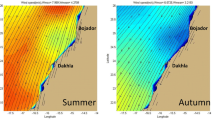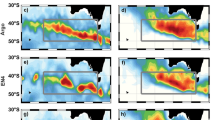Abstract
The mixed layer depth (MLD) is an active part of the marine environment that couples the underlying ocean to the atmosphere. The aim of this original study in Morocco is to investigate for the period 2002–2014 the relationship between the variability of the MLD with the oceanic sea surface properties and the primary productivity in the Cap Ghir region. This area is very productive along the Atlantic coast of Morocco and we examined in this study the monthly variability of the MLD and its relationship with sea surface properties using data from Copernicus—Marine environment monitoring products, coupling between MLD with SST and upwelling activity in the Cape Ghir area. During winter seasons, the MLD is deeper and observed at around 90 m. Compared to others seasons, it is varying between 10 and 25 m. The monthly mean SST show very cold temperature (around 17 °C) during winter season and a warm temperature (around 23 °C), during summer season. In fact, the colder waters in surface coincide with the deepest MLD and the warmer waters coincide with the shallowest MLD. From 2009 to 2011, the MLD was very shallower (40 m) with some observed variability between 30°30N and 31°N, due to the dynamic of Cape Ghir. Regarding to the upwelling activity, the upwelling index shows a clear seasonality (higher activity in summer and weaker in winters) and some relationship between the upwelling index and the MLD were investigated. The characteristic’s feature of the variability of the MLD mixed layer in the Cape Ghir area is based on the fast response of the upwelling activity than the other parameters like SST. When the MLD is shallower, the SST is still cooler for two months more. The oceanographic dynamic of the Cape Ghir area is very complex in nature and, following the MLD, this parameter is an adequate parameter for detecting the activity of the upwelling in this area.










Similar content being viewed by others
References
Aumont O, Bopp L (2006) Globalizing results from ocean in situ iron fertilization studies. Glob Biogeochem Cycles 20(2):GB2017. https://doi.org/10.1029/2005GB002591
Aumont O, Bopp L, Schulz M (2008) What does temporal variability in aeolian dust deposition contribute to sea-surface iron and chlorophyll distributions? Geophy Res Lett 35:L07607
Bopp L, Aumont O, Cadule P, Alvain S, Gehlen M (2005) Response of diatoms distribution to global. 32:L19606
Clayson L, Kantha H, Anne C (2000) Numerical models of oceans and oceanic processes. Academic Press
Egbert G, Erofeeva S (2002) Efficient inverse modeling of barotropic ocean tides. J Atmos Oceanic Technol 19:183–204
Itoh S, Yasuda I, Saito H, Tsuda A, Komatsu K (2015) Mixed layer depth and chlorophyll a: profiling float observations in the Kuroshio–Oyashio Extension region. J Mar Syst 1–14
Kara AB, Rochford PA, Hurlburt HE (2003) Mixed layer depth variability overthe global ocean. J Geophys 108:3079. https://doi.org/10.1029/2000JC000736),
Key R, Kozyr A, Sabine C, Lee K, Wanninkhof R, Bullister J, Peng T (2004) A global ocean carbon climatology: results from Global Data Analysis Project (GLODAP). Global Biogeochem Cycles 18, GB4031
Large W, Yeager S (2004) Diurnal to decadal global forcing for ocean and sea-ice models: the data sets and flux climatologies. NCAR technical notes
Levier B, Benkiran M, Reffray G, Sotillo M (2014) IBIRYS: a regional high resolution reanalysis (physical and biogeochemical) over the European North East Shelf. EGU 2014
Ludwig W, Probst J, Kempe S (1996) Predicting the oceanic input of organic carbon by continental erosion. Global Biogeochem Cycles 10:23–41
Lyard F, Lefevre F, Letellier T, Francis O (2006) Modelling the global ocean tides: modern insights from FES2004. Ocean Dyn 56:394–415
Madec G (2008) NEMO ocean general circulation model. Reference Manual. Internal Report. LODYC/IPSL, Paris
Makaoui A, Orbi A, Hilmi K, Zizah S, Larissi J, Talbi M (2005) L’upwelling de la côte atlantique du Maroc entre 1994 et 1998. Comptes Rendus Geosci 337:16, 1518–1524
Makaoui A, Orbi A, Arestigui J, Azzouz A, Laarissi J, Agouzouk A, Hilmi K (2012) Hydrological seasonality of cape Ghir filament in Morocco. Hydrological seasonality of cape Ghir filament in Morocco. vol 4, 5–13
Monterey G, Levitus S (1997) Seasonal variability of mixed layer depth for the World Ocean. NOAA Atlas NESDIS 14:100
Obata A, Ishizaka J, Endoh M (1996) Global verification of critical depth theory for phytoplankton bloom with climatological in situ temperature and satellite ocean color data. J Geophys Res 20657–20667
Polovina JJ, Mitchum GT, Evans GT (1995) Decadal and basinscale variation in mixed layer depth and the impact on biological production in the central and North Pacific. Deep Sea Res Part I 42:88
Rayner N, Parker D, Horton E, Folland C, Alexander L, Rowell D, Kaplan A (2003) Global analyses of sea surface temperature, sea ice, and night marine air temperature since the late nineteenth century. Geophys 4407
Reynolds R, Smith T, Liu C, Chelton D, Casey K, Schlax M (2007) Daily high-resolution-blended analyses for sea surface temperature. J Clim 5473–5496
Sotillo MG, Cailleau S, Lorente P, Levier B, Aznar R, Reffray G, Alvarez-Fanjul E (2015) The MyOcean IBI ocean forecast and reanalysis systems: operational products and roadmap to the future Copernicus Service. J Oper Oceanogr. https://doi.org/10.1080/1755876X.2015.1014663
Sverdrup HU (1953) On conditions for the vernal blooming of phytoplankton. ICES J Mar Sci 287–295
Taylor JR, Ferrari R (2011) Shutdown of turbulent convection as a new criterion for the onset of spring phytoplankton blooms. Limnol Oceanogr
Umlauf L, Burchard H (2003) A generic length-scale equation for geophysical turbulence models. J Marine Res 235–265
Acknowledgements
This study has been conducted using Copernicus—Marine environment monitoring service products. Regarding observational data sources displayed in the present paper, the authors express gratitude to Copernicus—Marine environment monitoring services.
Author information
Authors and Affiliations
Corresponding author
Rights and permissions
About this article
Cite this article
Bessa, I., Makaoui, A., Hilmi, K. et al. Variability of the mixed layer depth and the ocean surface properties in the Cape Ghir region, Morocco for the period 2002–2014. Model. Earth Syst. Environ. 4, 151–160 (2018). https://doi.org/10.1007/s40808-018-0411-7
Received:
Accepted:
Published:
Issue Date:
DOI: https://doi.org/10.1007/s40808-018-0411-7




